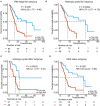A Long Non-coding RNA Signature to Improve Prognostic Prediction of Pancreatic Ductal Adenocarcinoma
- PMID: 31781487
- PMCID: PMC6857660
- DOI: 10.3389/fonc.2019.01160
A Long Non-coding RNA Signature to Improve Prognostic Prediction of Pancreatic Ductal Adenocarcinoma
Abstract
Background: Pancreatic ductal adenocarcinoma (PDAC) remains one of the most aggressive solid malignant tumors worldwide. Increasing investigations demonstrate that long non-coding RNAs (lncRNAs) expression is abnormally dysregulated in cancers. It is crucial to identify and predict the prognosis of patients for the selection of further therapeutic treatment. Methods: PDAC lncRNAs abundance profiles were used to establish a signature that could better predict the prognosis of PDAC patients. The least absolute shrinkage and selection operator (LASSO) Cox regression model was applied to establish a multi-lncRNA signature in the TCGA training cohort (N = 107). The signature was then validated in a TCGA validation cohort (N = 70) and another independent Fudan cohort (N = 46). Results: A five-lncRNA signature was constructed and it was significantly related to the overall survival (OS), either in the training or validation cohorts. Through the subgroup and Cox regression analyses, the signature was proven to be independent of other clinic-pathologic parameters. Receiver operating characteristic curve (ROC) analysis also indicated that our signature had a better predictive capacity of PDAC prognosis. Furthermore, ClueGO and CluePedia analyses showed that a number of cancer-related and drug response pathways were enriched in high risk groups. Conclusions: Identifying the five-lncRNA signature (RP11-159F24.5, RP11-744N12.2, RP11-388M20.1, RP11-356C4.5, CTC-459F4.9) may provide insight into personalized prognosis prediction and new therapies for PDAC patients.
Keywords: lncRNA; overall survival; pancreatic ductal adenocarcinoma; prognosis; signature.
Copyright © 2019 Zhou, Wang, Zhou, Zhao, Xia, Chen, Zheng, Xue, Yang, Fu, Yin, Atyah, Qin, Zhao, Bruns, Jia, Ren and Dong.
Figures






Similar articles
-
Five key lncRNAs considered as prognostic targets for predicting pancreatic ductal adenocarcinoma.J Cell Biochem. 2018 Jun;119(6):4559-4569. doi: 10.1002/jcb.26598. Epub 2018 Feb 27. J Cell Biochem. 2018. PMID: 29239017 Free PMC article.
-
A robust 6-mRNA signature for prognosis prediction of pancreatic ductal adenocarcinoma.Int J Biol Sci. 2019 Aug 22;15(11):2282-2295. doi: 10.7150/ijbs.32899. eCollection 2019. Int J Biol Sci. 2019. PMID: 31595147 Free PMC article.
-
A novel immunogenomic signature to predict prognosis and reveal immune infiltration characteristics in pancreatic ductal adenocarcinoma.Precis Clin Med. 2022 Apr 25;5(2):pbac010. doi: 10.1093/pcmedi/pbac010. eCollection 2022 Jun. Precis Clin Med. 2022. PMID: 35694712 Free PMC article.
-
A novel seven-lncRNA signature for prognosis prediction in hepatocellular carcinoma.J Cell Biochem. 2019 Jan;120(1):213-223. doi: 10.1002/jcb.27321. Epub 2018 Sep 11. J Cell Biochem. 2019. PMID: 30206981
-
Long Non-Coding RNAs and Metabolic Rewiring in Pancreatic Cancer.Cancers (Basel). 2023 Jul 4;15(13):3486. doi: 10.3390/cancers15133486. Cancers (Basel). 2023. PMID: 37444595 Free PMC article. Review.
Cited by
-
A four-long noncoding RNA signature predicts survival of hepatocellular carcinoma patients.J Clin Lab Anal. 2020 Sep;34(9):e23377. doi: 10.1002/jcla.23377. Epub 2020 May 30. J Clin Lab Anal. 2020. PMID: 32474975 Free PMC article.
-
The Biological Function Delineated Across Pan-Cancer Levels Through lncRNA-Based Prognostic Risk Assessment Factors for Pancreatic Cancer.Front Cell Dev Biol. 2021 Jun 14;9:694652. doi: 10.3389/fcell.2021.694652. eCollection 2021. Front Cell Dev Biol. 2021. PMID: 34195204 Free PMC article.
-
The lncRNA ENSG00000254041.1 promotes cell invasiveness and associates with poor prognosis of pancreatic ductal adenocarcinoma.Aging (Albany NY). 2020 Feb 23;12(4):3647-3661. doi: 10.18632/aging.102835. Epub 2020 Feb 23. Aging (Albany NY). 2020. PMID: 32090981 Free PMC article.
-
Epigenetic Regulation in Exposome-Induced Tumorigenesis: Emerging Roles of ncRNAs.Biomolecules. 2022 Mar 28;12(4):513. doi: 10.3390/biom12040513. Biomolecules. 2022. PMID: 35454102 Free PMC article. Review.
-
A Comprehensive Risk Assessment and Stratification Model of Papillary Thyroid Carcinoma Based on the Autophagy-Related LncRNAs.Front Oncol. 2022 Feb 24;11:771556. doi: 10.3389/fonc.2021.771556. eCollection 2021. Front Oncol. 2022. PMID: 35284335 Free PMC article.
References
LinkOut - more resources
Full Text Sources

